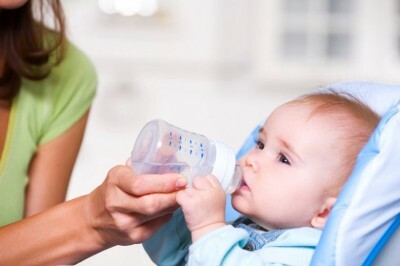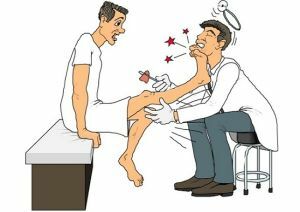 Standard methods used by medicine for many years, sometimes are much more effective than new-fangled technologies.
Standard methods used by medicine for many years, sometimes are much more effective than new-fangled technologies.
One of such methods of neurological research includes the examination of the functioning of the knee( patellar) reflex. This is one of the first reflexes that are tested on a neurological examination.
The concept of a reflex arc and response
Reflex refers to the withdrawal of an organism to an external factor. The response is regulated by the nervous system, and the path through which the nerve impulse passes is called the reflex arc. It includes the perceiving nerve ending, the sensitive, motor, intercalary and executive neurons.
The static element of the reflex works while the muscle is in a stretched state. The dynamic element functions for a few moments, manifesting itself as a response to a dramatic transformation of the length of the muscle. The basis of the two-component reflex is concluded in the presence of two types of intrafusal muscle fibers:
- Responsible for the static moment , called chain-like and capable of stretching evenly. In the extended state, they allow increasing the frequency of the signals.
- Responsible for the movement component , marsupial fibers, have a convexity in the center, due to which they are more elastic. When exposed to rapid stretching, the middle first stretches first, then the lateral portions, the expansion of which can accompany the compression of the central part. As a result, the impulse from the nerve ending first speaks about stretching, and then about compression, that is, about the oscillation of the length of the muscle.
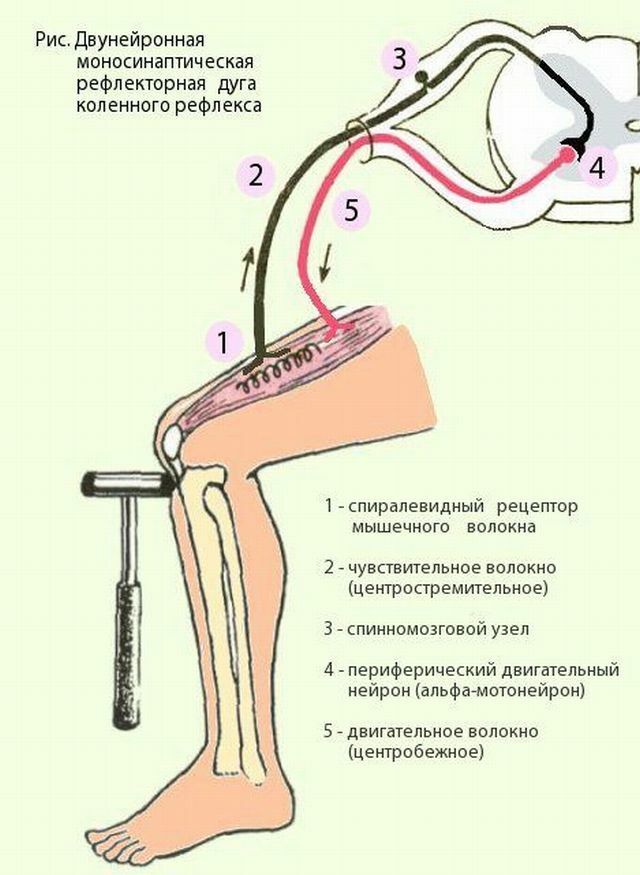
Reflex monosynaptic arc of the knee reflex schematically
The presence of reflex pulses ensures human safety and a normal reaction to changes in the environment.
In addition to this arc, there is a connection between the tendon reflex and other neuronal processes that ensure intersegmental movement of impulses along the ascending and descending pathways. The section of the spinal cord at the waist signals to the brain, helping to realize a conscious response to the key transformations occurring in the body. The person feels that his leg is straightened. These are rising currents.
The return paths take part in the creation of conscious movements, providing an arbitrary contraction of some muscles and relaxation of others. Accordingly, the reflexes have a close relationship with the centers of the brain, which are located in the cortex and other zones.
Reflex check: physiology and pathology
When the stimulus is activated, the impulse is sensed by the sensitive endings, then it is transmitted along the afferent nerves to the spinal cord efferent centers 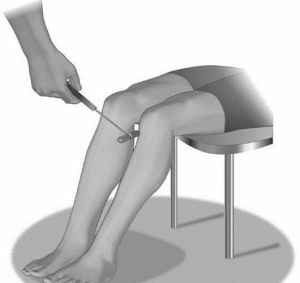 , where information is instantly processed and a return signal is sent when it reaches the muscles, they contract, and part of the body comes tomotion.
, where information is instantly processed and a return signal is sent when it reaches the muscles, they contract, and part of the body comes tomotion.
The absence of a knee reflex indicates that the patient suffers from a disease of muscle tissue, brain and other parts of the nervous system, or is in a severe emotional state.
During the check of the knee reflex neuropathologist strikes a special hammer on the basis of the tendon of the quadriceps muscle, awakening in it a nerve impulse, the response to which must be compression of the muscle fiber and the movement of the foot. The strength of the impact does not matter, it is important to correctly hit the malleus and relax the legs.
The normal reaction of the knee reflex is carried out at the expense of several stages:
- , as a result of hammering the tendon, it stretches, resulting in the formation of a receptor potential;
- in the axon is provoked by the action potential, it enters the spinal cord and is transferred to the motor neuron;
- on the long process of the nerve cell the message moves to the gastrocnemius muscle;
- it shrinks, and the leg twitches.
If the applied method of assessing the knee reflex has not worked, its manifestation can be assessed in other ways:
The- of the examinee is placed on a chair in such a way that the toes of his feet are on the floor, and the legs are slightly more straight than the straight, the impact is from the top to the bottom of the protruding patella, which must rise in the process;
- have the necessary leg above the knee of the second and strike;
- use a high seat, on which the patient's legs will hang, and therefore, be in a state of relaxation;The
- of the examinee is placed on the back, and the knees are laid one on the other.
Why the knee reflex
 falls out For medicine, the knee reflex serves as one of the most important and simple means of testing the efficacy of the largest nerve of the thigh and the functioning of the lumbar spinal segments from 2 to 4.
falls out For medicine, the knee reflex serves as one of the most important and simple means of testing the efficacy of the largest nerve of the thigh and the functioning of the lumbar spinal segments from 2 to 4.
The fact of its absence, decrease or excess, indicates the presence of separate brain diseases. The tendon reflex( which refers to the patellar) refers to permanent, extremely rare cases when a healthy person is unable to show it, usually it is associated with a childhood illness.
In the standard state, the patellar reflex manifests itself with an average level of expression called normoreflexia. In case of violations, the signal level changes, which allows using this reflex as a diagnostic method.
Some diseases have obvious manifestations in the deviations of this reflex.
Diseases associated with violations of the patellar reflex
If the knee reflexes are found to be elevated in the check process, this is manifested in an excessive extension of the shin, which can be observed with deterioration of the braking processes that are realized by the brain due to pyramidal pathways and signaled by an increase in spinal reactions of motion.
This occurs with a symptomatic complex of spastic paralysis or pathology affecting the motor fibers: radiculitis, plexitis, neuritis and poisoning.
An increase in the reflex can also occur in a completely healthy person, but with a neurotic warehouse. An increase in the knee reflex may lead to a sharp reduction in the individual muscle groups in the region of the patella.
The decrease in the activity of the patellar reflex manifests itself as a consequence of a failure in the movement of the pulse along the external motoneuron, with damage to its central part and processes.
Accordingly, the source of the disorder is in the anterior horn of the lumbar spinal cord, its roots, nerves and their plexus. The same reason can be that the reflex arc of the knee reflex is broken at the stage of the sensory link.
In this case, initially determine the arc phase in which the failure occurred, then draw conclusions and prescribe the treatment.
It is also possible that the reaction is completely absent, which shows a significant lesion of the nervous system, for example, paralysis. Influenced also on the fall of the knee reaction, the transferred infectious diseases of the central nervous system, nervous exhaustion, muscle damage.
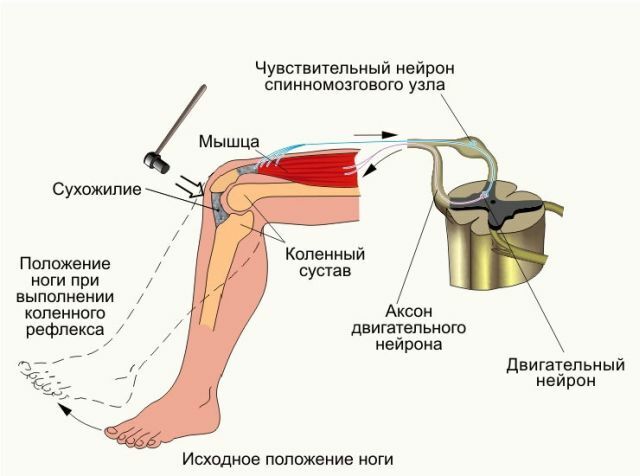
Knee Reaction Check Scheme
Temporary withdrawal of the knee reaction may result from:
- epileptic seizures;
- general anesthesia;
- crushing of the femoral artery.
In each situation, it is necessary to accurately assess the cause of the disease, the location of the lesion and the overall health of the patient, taking into account other symptoms. Only then it is determined with the diagnosis and the method of treatment.


